Vision Thing: ‘Tis the season for … books about car design?
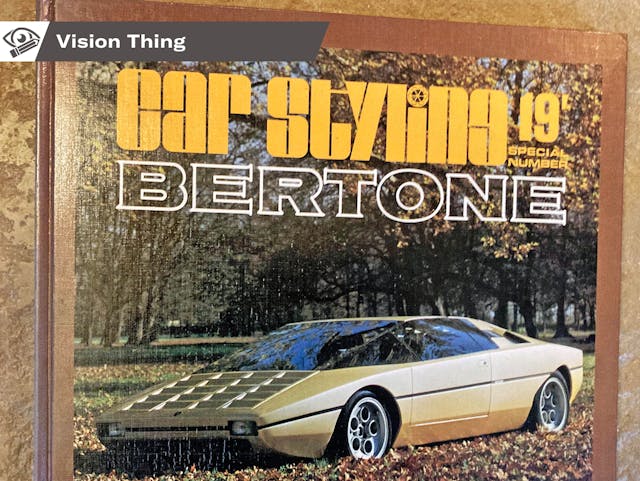
It’s nearly that time of year again. Even before Halloween landed, the lights went up in Coventry and the adverts started to appear on television. My black-clad brethren and I try to hold the line at the end of October but the rapacious tendrils of consumerism take no prisoners.
Maybe you can tell, but I’m not a big fan of Christmas. My holiday survival strategy for the last few years has been to retreat to a friend’s house in Wales, were we all eat ourselves into a food coma and wait for the whole sordid affair to blow over.
Trouble is, I do like getting presents, and I expect you do too. Prompted by a reader to share some of my favorite bits of reading material, what follows are several car design book recommendations to put on your gift list. All of these are from my personal bookshelf, so if I’ve missed something obvious it means I haven’t bought a copy yet. Share such titles in the comments.
H Point: The Fundamentals of Car Design & Packaging (Macey/Wardle, 2nd Edition)
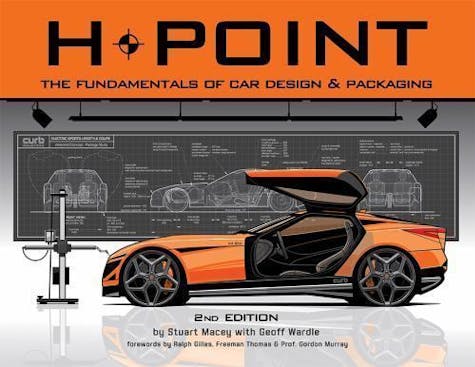
If such a thing as a definitive academic text book for car design exists, this is it. There’s a reason every student at basically every transport design course around the world is handed a copy on day one of their first year. The authors are both tutors at the Art Center in Pasadena, but this is not your typical dry, wordy academic tome.
Designers are visual people. So with the aid of lovely line drawings and simple to understand diagrams, this book looks at all of the engineering, legislative, production, and ergonomic factors a designer needs to consider. Covering everything from concept ideation to market positioning of a production vehicle, the only areas not touched on are aesthetics and styling. The title refers to the “Hip Point”; the height of the driver in relation to the ground plane, to give you some idea of the areas explained. This book is utterly essential for anyone who thinks car design is just about drawing cool cars.
How to Design Cars Like a Pro (Lewin/Borroff)
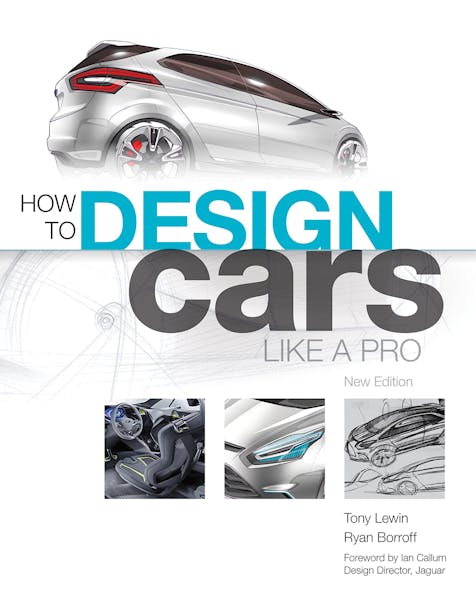
A terrific “catch all” book that makes a perfect companion to H Point. It looks at the more creative side of vehicle design. Concentrating on the aesthetics and form of exteriors and interiors, there are interviews with leading designers and students (along with examples of their work), chapters on defining what car design actually is, how cars go from concept to production, what makes good design and the challenges of the future.
But it doesn’t neglect the past; design classics and the men who created them are in here as well. And if you want to have a go yourself, there are even sketching and rendering tutorials. It’s a little dated given that it’s twelve years old, but this book gives a good solid overview of the visual basics without getting bogged down in pseudo-intellectual waffle. Don’t let the publication date put you off; along with H Point these two are what you should read before anything else.
Secret Fords Volume 1 & 2 (Steve Saxty)
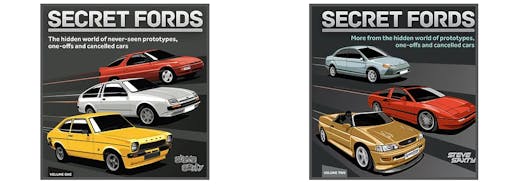
Going from the how of car design to the why, Steve Saxty is a veteran Ford insider (and Hagerty contributor) who has unprecedented access to the Ford design archives. He had so much material comprising of studio photographs, development sketches and renders as well as interviews with all the principles involved that it took two books to manage it all.
Across both volumes is the inside story of Ford of Europe’s design and product development from the mid-Seventies until the mid-Nineties. Although the focus (ha!) is primarily on Ford Europe, the role of Dearborn in these stories is not neglected. In fact, the strength of these books is the way it paints a picture of the politics and the personalities from all across the Ford empire that influenced design decisions. Among these was a redo of the MkII Focus ordered by J Mays on his arrival, to make it look more like a VW (the company which Mays had worked previously). The sheer depth of previously unseen images contained here is absolutely staggering. The presentation along with some of the commissioned illustrations of unbuilt concepts is a bit garish, but if you’ve ever wanted the inside story view of a car from conception to production, how a design progresses and all the drama that entails, Secret Fords is a must read.
A Century of Automotive Style: 100 Years of American Car Design (Lamm/Holls)

The absolute bible on American car design, from the turn of the century until the early Nineties. Exhaustively researched and written, if you’ve ever wanted to know about the personalities and techniques from the early days of adopting ship building techniques through to the introduction of CAD, this is your book. Chronologically covering all the main domestic manufacturers and coachbuilders, their hits and misses, as well as the emerging trends and external influences, the book weaves people, products and technologies into a thorough and engaging history lesson. It’s very text-heavy, and the majority of the photography is unsurprisingly black and white, but you’ll find information and stories here from the past you won’t find anywhere else. It doesn’t appear to be in print currently, so you’ll have to track down a used copy. But it’s an extremely valuable addition to your bookshelf.
Car Design America/Europe/Asia (Tumminelli)

Now we’re getting slightly more into the realm of glossy coffee table books. Each volume looks at all the major design highlights across the three regions, tracing the visual themes and fashions through the years from the beginning of the war until the time of publication. Lavishly stuffed with lots of color period photographs, the author adds historical context and shows the progression of how the appearance of cars has changed through the years.
This series is basically a pictorial encyclopedia of the evolution of car design, interspersed with important landmark vehicles. The author reaches a little in that he attempts to give form and name to some of the aesthetic movements that feel a bit arbitrary, but these are an extensive and lush books that provide a go to visual reference. It looks like they may be out of print currently, but are absolutely worth tracking down.
Cars: Freedom, Style, Sex, Power, Motion, Colour, Everything (Bayley)
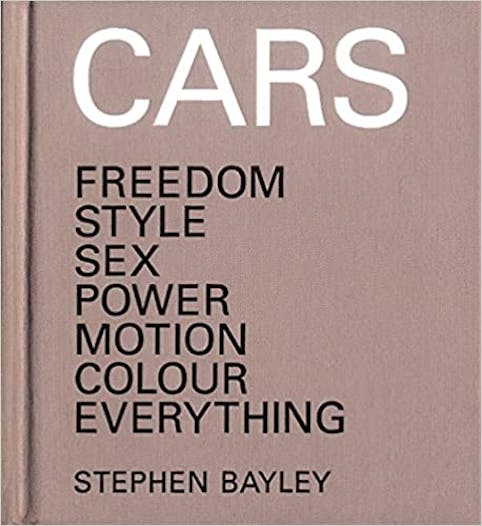
An appropriately excessive title for an excessively sumptuous book: Stephen Bayley is one of those incredibly intelligent and engaging writers that pulls off the rare trick of making the reader feel smarter. A highly regarded design critic and commentator, he can apply cultural and socio-economic context to design in an intelligent but accessible way that is second to none. This is a car book not really about cars. Rather, it celebrates the car as an expression of human ingenuity and creativity—an object to be considered in the same manner as other art forms.
In this book, with albeit subjective perspective, Bayley does exactly that. He selects eighty or so cars that have elevated the discipline of car design: an expert’s greatest hits. Each individual model has been treated to extensive studio photography in black and white, which might seem cliché but places the emphasis on the forms being considered. If you want to expand the way you think about how a car arrives at its final form, this is your book. Bayley’s commentary on the ’59 Cadillac Eldorado: “A pink Cadillac embodies the American concept of luxury and style at mid-century: untethered, unexamined, gross, inimitable, unforgettable and unique”. There’s a few different versions of this kicking about; get the full-size door stopper that has the page size to do the stunning images justice.
Crayon to CAD: A History of Post War Automotive Design in Australia (Berenger)

We often think of car design being a strictly American, European or Asian affair, but of course there is another country with a long and proud history of designing and manufacturing cars: Australia.
This wonderful book brings this often forgotten heritage out into the open. Starting with a brief history, it has chapters explaining in detail the design processes and tools used, the main studios in the country, before going on to tell the story of Australian car design and the unique challenges faced. There’s also an in depth look at how the introduction of new materials and technologies had on the development of components such as lights, wheels, and bumpers. A terrific overview from start to finish of the designer’s role in getting new cars to market.
Car Styling Quarterly

Finally, a bonus treasure hunt for the committed: Car Styling Quarterly was a perfect bound Japanese magazine (the early issues are basically books) that appeared in 1973 and carried on until about 2017. Imagine a designer’s go-to magazine for what’s happening elsewhere and you’ve got the idea. Each issue covered the important recent releases and their design story, mostly in images and sketches, but slotted in contemporary industrial and transport design as well. Much more than a historical curio, these are worth seeking out because, again, they contain images you won’t see elsewhere.
Being Japanese, the layouts and copy can best be described as quirky, but that just adds to their charm. They are bi-lingual with the text printed in English—useful if, like me, your grasp of Japanese is utterly non-existent. Online information is scarce so it’s almost impossible to figure out the contents of each issue, but these are well worth picking up if you stumble upon them either online or out in the wild.
These are all books that I’ve bought over the course of my studies and career. To this day I find them extremely useful. There are a lot more available, but I don’t want to recommend anything I’ve not actually read, and I’m already running out of shelf space. Get these for the holidays and you’ll likely enjoy the December season far more than you would have otherwise!
***
Adrian Clarke is a professional car designer, earning a degree in automotive design from Coventry University and a Masters in Vehicle Design from the Royal College of Art in London. He worked for several years at a major European OEM, and in the ’90s his daily driver in London was a 1979 Ford Thunderbird.


I like this. Can’t give it a like, so this comment will have to do.
Thank you, glad it’s useful.
Thanks for a terrific list. And thanks for not going for the multi thousand dollar book that looks like a motor, but ones that ironically seem to be about content, not style.
I tend to take a pretty dim view of those super expensive ‘collectors edition’ type tomes that amount to little more than visual masturbation for the deep of wallet. I specifically tried to keep to books about design that would be useful to the reader – although some of these are out of print they shouldn’t be too expensive (less than $100) to get hold of.